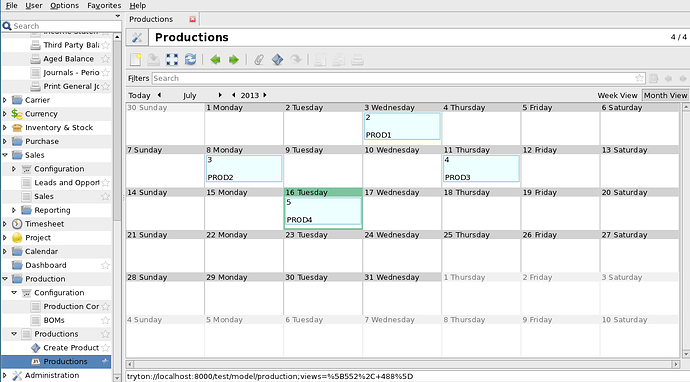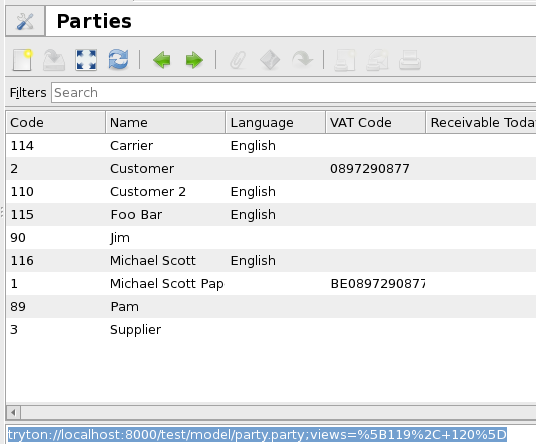We are happy to announce the 3.0 release of Tryton.
This release brings a new calendar view for the graphical user interface and sees the result of a large refactoring of the code started 2 years ago with the project python-sql. But also as usual there are many bug-fixes, improvements and new modules (see below).
Of course, migration from previous series is fully supported.
Major changes in graphical user interface
- A calendar view is now available. It allows to display records on a calendar using a start and/or an end date/datetime fields. It supports the Drag & Drop of events and the edition on double-click. The view is optimized to fetch only the events displayed.
- The URL scheme, introduced in 2.0, is now accessible at the bottom of all tabs. This URL allows to open the same tab on any other client.
-
The request has been removed. It is suggested to use emails with URL instead.
-
The selected records in list view is remembered between sessions.
Major changes on the server side
-
The server uses now python-sql to generate the SQL queries. This change brings a better compatibility with all the different Databases currently supported (and also with the future ones).
-
The searcher method can now return a full domain (instead of one limited to
ANDclause only). -
The older order_field attribute is replaced by method order_ to be more modular.
-
The database backend can be loaded dynamically which means it is possible to define one in a external package of trytond.
-
The performance of MPTT storage has been improved by removing the default order and reducing the number of queries.
-
A new attribute
groupedcan be added on thedatatag. It allows to create all the records of the same Model at once. This improves the installation time of modules with large sets of data. -
It is possible to define a default order on the Action Window.
Modules
- Many modules have been adapted to a new design to link generated documents with their origin. Instead of copying the code of the origin as reference, a Reference field is used and most of the time the field is on the lines. This brings a better vision of the links between documents without loosing information when merge of documents occurs.
Account
- A new wizard appears to ease the creation of the balance move for non-deferral accounts at the end of the fiscal year.
- All accounts of a chart must always be in the same company. This constraint improves drastically the performance of computing the debit/credit.
- Any move posted with one line of zero is automatically reconciled if it is on an account to reconcile. With this feature, invoices with amount of zero are automatically marked as paid.
- The centralised counterpart option on journal has been removed.
Account Invoice
- Once an invoice is posted, the account move is used to show the amounts instead of computing it from the lines. This improves a little bit the performance especially for invoices with a lot of lines.
Account Statement
- Now it is possible to directly set an invoice on a statement line. This will fill the party and account automatically.
Stock
- It is now possible to query the stock quantity with any kind of grouping parameters. For example, it can be used to compute the stock quantity of a lot instead of a product.
- The code of inventory has been reworked to allow easy customization of the move creation and also of the unique constraint on the inventory lines.
- The period cache can now be adapted to cache different kind of grouped quantities.
Stock Lot
- The quantity and forecast quantity fields have been added on lot.
- It is now possible to create inventories with lot.
- The period cache stores also the quantities per lot.
Stock Supply
- A new wizard appears to create automatically internal shipments.
- If there are late supplier moves when creating purchase requests, the wizard shows a warning to allow the user to change the date of those moves into the future if needed otherwise those incoming moves will be ignored.
New modules
- The
Bankmodule defines the concept of bank and account. - The
Account Dunningmodule allows to manage the dunning following a procedure with different levels. - The
Account Dunning Lettermodule adds the generation of a letter when processing dunnings. - The
Sale Invoice Groupingmodule adds an option to define how invoice lines generated from sales will be grouped.

